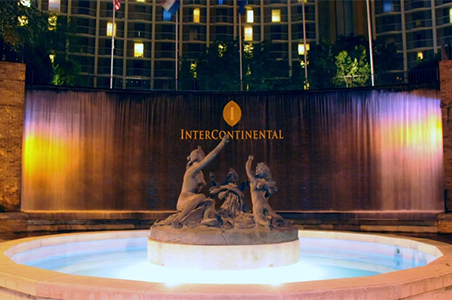NADE Annual Conference:
2025 NADE & AFDE SYMPOSIUM
"Examining Paper
Documents in a Digital World"
Kansas City, Missouri
Friday, October 3 (8:00 am) - Sunday October 5 (5:30 pm), 2025

We hope you will join us for an interesting and informative program.

Hotel room rates are $169.00 plus taxes per night (single or double), and include a free parking and internet. The hotel room rates apply three days before and three days after the symposium. For information on how to reserve a room, click here. Room reservation is online at this link.
Deep Metadata in PDFs: Hidden Digital Fingerprints - What Forensic Document Examiners Need to Know About Metadata
Celeste Makoff
Every digital document tells two stories. The first is what you see - the text, images and formatting. The second story is invisible, but revealing - written in the document's deep metadata. Deep metadata can reveal revisions made, devises and software involved with the document, and the history of the document's creation.
In the digital realm, it is a fundamental law that every action must leave a trace. The metadata instructs the computer about every font, color, images placement, and more. Understanding what metadata exists and why can turn the metadata into powerful tool for the FDE.
Celeste Makoff
Think of AI models as incredibly sophisticated pattern matching machines. They’ve been trained on millions of documents – learning what real contracts look like, how people typically write emails, what authentic signatures contain, etc. Just like a child learns language by hearing thousands of conversations, AI learns document creation by studying countless examples. When you ask AI to create something it is essentially saying “Based on the millions of examples I’ve seen, this is what should come next. It is prediction – not understanding – but it is getting frighteningly good at mimicking authenticity. This presentation will explore how AI may influence the field of forensic document examination.
Rosanna Coccaro
In forensic handwriting examination, the handwriting is only available on paper, and thus the kinematics of the handwriting movement is partially lost. We argue that the lost information, namely the velocity profile, is paramount for accurately characterizing the samples under investigation and their comparison. We address this issue by reformulating the problem as a time-optimal trajectory planning one and introducing an algorithm that assigns velocity profiles to the offline data. We report the results of the experiments we have designed and performed, that show that enriching the path of the ink with the velocity profile provided by our algorithm provides us with a good approximation of the human sample and preserves the intra-writer variability. Based on these findings, we have outlined a procedure for implementing a thoughtful and quantitative comparison between the handwriting samples under examination, showing how the results may provide robust evidence to the examiner for achieving the final decision.
Chris Angles, Attorney
Attorneys and Experts work separately in their own specialties, but then work together to present a comprehensive presentation to a trier of fact. Most attorneys have zero or minimal experience working with a forensic document examiner, so it is important for the expert to help the attorney understand how to best capitalize on the information the expert has to offer. That is the focus of this presentation.
Which Hole is Which
Robin Williams, D-BFDE and Tamara Kaiden, FDE
This presentation will Introduce to the attendees the
different styles/classes of staplers, staples and their
relationship to one another. It is common for a document
examiner to encounter issues related to page substitution.
Whenever it is suspected that pages have been substituted in
a document bound with staples, a careful study of all staple
holes in each page/sheet should be made. If a sheet does not
contain the same number of holes as the other pages, or the
position of the hole(s) on a sheet does not match those of
the other sheets, then it is an indication that at one time
not all of the pages were part of the collection of sheets
or unit of sheets. The presenters will explain how to
resolve such issues related to staple holes in paper
documents by aligning, counting and identifying accurately
which holes are created by the actual perforation of the
paper created by the stapler/staple, versus analogous
perforations created by the stapler/staple.
Susan Abbey, CDE, D-BFDE
With cases involving initials, what are the best procedures? What does the literature say?
The literature is surprisingly sparse in this important area. In this presentation references from authoritative books and journals that are available will be cited. Examples of cases where there are suspected page substitutions and other types of cases where initials can create difficulties or questions of authenticity will be explored. Sources of initials for comparison purposes will be suggested.
Jonathan Heckeroth, MSc.
Heidi H. Harralson, CDE
Kurt E. Kuhn, FDE
Emily J. Will, CDE, D-BFDE
Thomas Phinney, MS, MBA, Font Detective
History and Features of U.S. Currency Notes
Christopher Burke
This presentation will showcase the history and document features of U.S. Currency Notes. Items covered during this presentation include: graphic features, material composition, note production method, counterfeit note identification, and historical U.S. banknotes with examples. This presentation will offer a brief overview of some methods used to authenticate documents and identify markers of potentially counterfeit documents and provide real-world examples of counterfeit notes.
Ben Rose
We work in a world that’s intertwined between physical and digital documents. Forensic Document Examiners provide expertise in examining the content of a document, focusing on handwriting, ink, and signatures, to name a few. Digital Forensic Analysts identify, collect, preserve, analyze and produce Electronically Stored Information, also known as “ESI.” Documents are collected in “forensically sound” and “defensible” methods and are authenticated with digital technologies. Examinations focus on file metadata, as well as contextual information which may be identified on the device(s) that created, stored and transmitted the documents. This presentation aims to inform the audience on the protocols, tools, capabilities and limitations encountered in the digital forensics world.
Robin Williams, D-BFDE and Tamara Kaiden, FDE
Highly stylized signatures can raise some difficulty for examiners depending upon whether enough exemplars were made available to the examiner and/or whether a useful pattern is observed. This workshop will be presented as a practical exercise related to highly stylized signatures. The participants will examine the signatures along with exemplars and provide opinions as to the genuineness of each signature presented. After the examinations have been completed, discussions will be held involving the opinions of each of the signatures.
M. Patricia Fisher, D-BFDE
In a recent case, my client informed me that a paralegal in their office had used AI on the Claude app, one of the frequently used AI apps, to analyze the same evidence that I had analyzed. She said our opinions were similar. I told the client that I did not want to know any more until after my testimony. This presentation will show the PowerPoint slides from my testimony and then show the results from Claude. I also asked Celeste Makoff, our presenter on metadata and AI, to run an additional signature that was more complex and closer to the actual signatures of the Decedent, through Chat GPT, Claude and other AI tools she uses. Attendees will learn the limitations of using AI for examinations and why it is important, for now, not to use AI apps in forming opinions.
Rima Askurava
Forensic Document Examiners are seeing an increase in the different types of signatures they receive or are asked to review – wet-inked signatures, photocopies, PDFs, electronic signatures, and signatures signed on iPads and other electronic devices. Several different digital signatures are electronic signatures that have security features, unlike electronic signatures that are simply cut and pasted into a document. These security features are both visible and invisible. For example, a DocuSign document contains a visible envelope number at the top left of the page and security features that can only be accessed with specialized software. Adobe digital signatures require to apply and validate certified digital signatures and provides access to certificate trust settings and signature panel. Each company that created digital signatures will create their own security features.
Attendees will learn the visible features and security features of the two leading companies who create digitally signed signatures – DocuSign and Adobe. Attendees will be better prepared to answer client’s questions when confronted with digital signatures and be directed to computer experts when necessary.
Beverly East
In a June 2025 a disputed signature case in the Supreme Court of New York involved two experts presenting different opinions regarding the validity of
a signature on an Amended Lease Agreement. This presentation includes the case report and highlights the following factors:
Why Experts differ!!
• Different training
• Different methodology
• Different documents examined
• Insufficient documents
• Cognitive bias
• Skill level of the experts
• Ethical issues
Tim Deathriage
Tim Deathriage is the discoverer and lead researcher of a mysterious handwritten, vellum document found buried in rural Tulare county in 1992, which purports to be a late 18th-century copy of the Declaration of Independence. The unusual provenance of this unauthenticated artifact began with Tim’s recovery of the document from the ground, followed by a period of 10 to 12 years during which it was displayed in their home. Now the subject of a rigorous, ongoing forensic and historical investigation, this document and its unique story have become a central focus of Tim and Trinity Deathriage’s research. In their presentation, Tim will provide a captivating, firsthand account of its journey, from the initial discovery to the complex process of its current examination.
- Plaza Area
- Country Club Plaza
- Kauffman Garden
- Nelson Atkins Museum of Art. The personal HR Bloch collection, it’s a must!
- Kemper Contemporary Museum of Art
- Thomas Hart Benton Home and Studio Museum 3613 Belleview Ave. Kansas City, MO 64111
- Crown Center Union Station
- World War I Museum If you are a history buff and have not been to this museum, it comes highly recommended
- Union Station Lots of activities, exhibits, Science City, restaurants and evidence from the 1933 Union Station Massacre between FBI, Frank Nash, Pretty Boy Floyd and others.
- Crown Center
- Kansas City Cross Roads Art District
- Boulevard Brewery You can take a brewery tour, but you have to get tickets ahead of time or you can enjoy their tasting room as well. Go to website for additional details
- Trolley Tour
- KC Gangster Tour
- Power and Light District Area/Crossroads Crossroads Building Murals Take a walking tour of the Crossroads.
- Bop into Thou Mayest Coffee Shop Up Down Bar Featuring 50 arcade games from the 80s and 90s, Pac Man, Yard Jenga and Connect Four
- Power and Light District College Basketball Experience The American Jazz Museum 18th and Vine Historic District in KC
- Negro Leagues Baseball Museum 1616 E 18th St, Kansas City, MO 64108
- Green Lady Lounge (KC Jazz) 1809 Grand Blvd
- Black Dolphin Lounge (Jazz) The Blue Room (KC Jazz) Tired of Driving? Take the Streetcar from Union Station to City Market and the Power and Light District. It’s free to ride!
- River Market Area
- River Market
- Steamboat Arabia Museum Food
- Bryants Barbeque (best in KC) Gates Barbeque
- Michael Smith’s Extra Virgin Restaurant
- Christopher Elbow Chocolatier Andre’s Chocolates and Restaurant 5018 Main St.
- To the East – Jackson County
- Truman
Library
- To the West – Western Wyandotte County
- The Legends
- Casinos
- Hollywood Casino at Kansas Speedway
- Lawrence, Kansas
- Downtown Lawrence
- Sports Museum at Allen Field House Natural Original Rules of Basketball are on display Spencer Museum of Art KU Campus
- Other
events can be found here